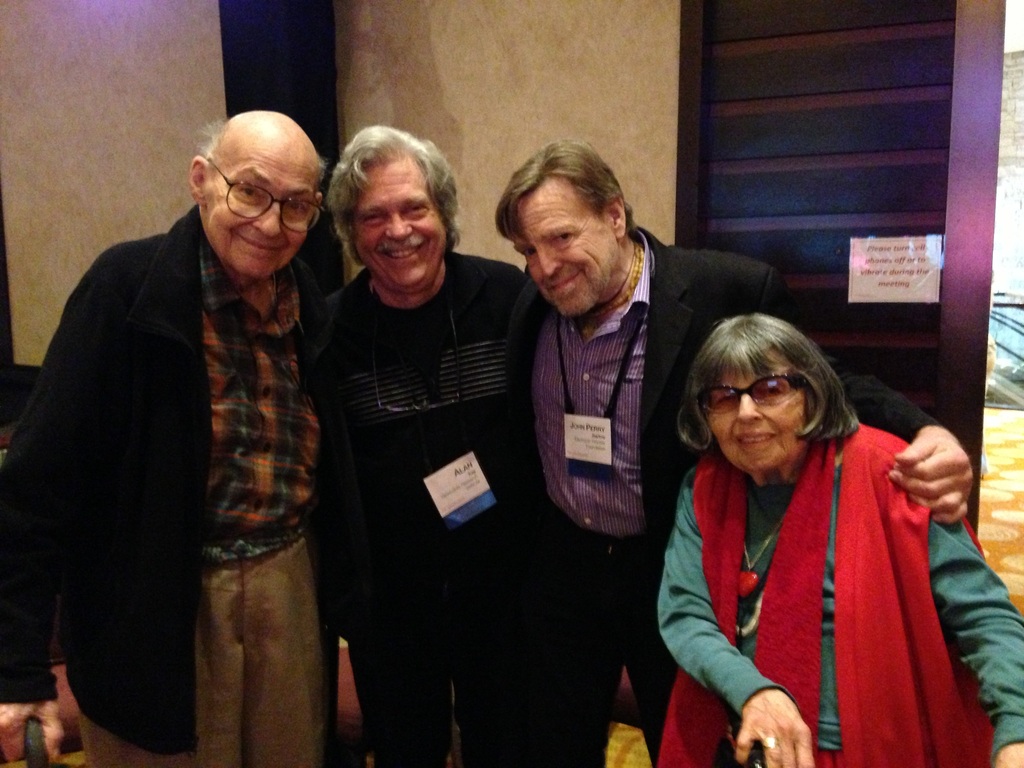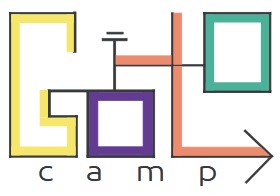Alan Kay and Marvin Minsky: Computer Science already has a “grammar”. Need "literature"

The first on the left is Marvin Minsky, the second on the left is Alan Kay, then John Perry Barlow and Gloria Minsky.
Q: How would you interpret Marvin Minsky’s idea that “Computer Science already has a grammar. What she needs is literature. ”
')
Alan Kay: The most interesting aspect of Ken's blog posting (including comments) is that nowhere can you find a historical reference to this idea. In fact, more than 50 years ago in the 60s there was a lot of talk about this and, as I recall, several articles.
I first heard about this idea from Bob Barton, in 1967 in the magistracy, then he told me that this idea was part of the motivation of Donald Knuth when he wrote “The Art of Programming”, whose heads were already going. One of Bob’s main questions at the time was about “programming languages meant to be read by people as well as machines”. And this was the main motivation for parts of the COBOL design in the early 60s. And, perhaps more importantly in the context of our topic, this idea is visible in a very early and rather beautifully designed interactive JOSS language (mainly Cliff Shaw).
As Frank Smith observed, literature begins with ideas that are worth discussing and writing down; it often partially generates views and extends existing languages and forms; this leads to new ideas about reading and writing; and, finally, to new ideas that were not part of the original motive.
Part of the idea of "oliteraturization" is reading and writing, and referring to other articles that may be of interest. For example, Marvin Minsky’s lecture on the Turing Award begins with “The problem with Computer Science today is obsessive care for form, not content . ”
He meant that the most important thing in calculations is the meaning, and how it can be viewed and presented, unlike one of the big themes of the 60s, about how to analyze programming and natural languages. For him, the most interesting thing in the thesis of Terry Vinograd graduate student was that at the same time it was not very correct from the point of view of English grammar (it was very good), but that it could give meaning to what was said and could justify what was said using of this value. (This is an echo of the past from what is reported by Ken in Marvin's blog).
A parallel way to look at the "universally studied language." A lot can be done without changes in the language and even without adding a dictionary. This is similar to how it is very easy to write a formula with mathematical symbols and syntax. This is partly what Marvin leads to. It's funny that the Turing machine in Marvin's book “Calculation: Finite and Infinite Machines” (one of my favorite books) is a fairly typical computer with two instructions (add 1 to the register and subtract 1 from the register and branches to the new instruction if the register is less than 0 - there are many options.)
This is a common programming language, but pay attention to the pitfalls. A reasonable solution to “universally studied” should also have certain types of expressive power, which are likely to take more time to study.
Don's interest in the so-called “literate programming” led to the creation of the author’s system (historically called WEB), which would allow Don to explain the program itself, which was written, and which included many functions that allowed extracting parts of the program for studying a person. The idea was that the WEB document was a program, and the compiler could extract compiled and executable parts from it.
Another early innovation is the idea of dynamic media, which was a popular idea in the late 60s, and for many of us was an important part of interactive computing on a PC. One of several motives for this idea was to have something like Newton's Principles, in which the “mathematics” was dynamic and could be launched and tied to graphics, etc. It was part of the motive to promote the idea of Dynabook in 1968 year One of the terms that began to be used then was “active essay,” where the types of presentation and argument that can be expected in an essay are enhanced by the fact that the interactive program is one of the many types of media for a new type of document.
Some very good examples were made in Hypercard by Ted Kyler himself in the late 80s and early 90s. Hypercard was not directly configured for this — the scripts were not media objects for the cards, but you could do some work and get the scripts to show on the cards and also make them interactive. A particularly provocative example was “Weasel”, which was an active essay explaining part of Richard Dawkins’s book “Blind Watchmaker”, allowing the reader to experiment with a framework that used a kind of reproduction process to search for targeted sentences.
It is worth thinking about the fact that, despite the fact that Hypercard was almost perfect for the emerging Internet - and its widespread adoption in the early 90s - the people who created the Internet decided not to accept it or the larger early ideas of Engelbart. And Apple, which had a lot of ARPA / Parc people in its research wing, refused to listen to them about the importance of the Internet and that Hypercard would start using a symmetrical reading and writing system. Apple refused to make the browser at the time when a really good browser would be a significant event, and, perhaps, would play a huge role in what the public face of the Internet turned out to be.
If we move forward for several years, we find absolute absurdity - even almost obscenity - a web browser without a real development system (think how stupid wiki development should work at all), and as one of many simple examples, a Wikipedia article, for example LOGO working on the computer, but not allowing the reader of the article to try programming LOGO from the article. This meant that what was important for computers was blocked for users in defense of various options for implementing old media.
It is worth thinking about the fact that Wikipedia was and is the main genre for thinking, inventing, implementing and writing the “literature of computations”, which is necessary (and this, of course, is related to both reading and writing many types of multimedia, including programming).
Even more worth thinking about is that I can’t write a program here, in this answer to Quora - in 2017! - This will help to show what I am trying to explain, despite the enormous computer power that underlies this weak idea of interactive media. The important question “what happened?” Is completely overlooked here.
To get an idea of the problem, here is the 1978 system, which we partially resurrected several years ago to pay tribute to Ted Nelson, and partly for pleasure.
(Please take a look here at 2:15)
The whole system is an early attempt to realize what I am talking about more than 40 years ago.
A striking example can be seen at 9:06.
In addition to the “dynamic objects”, one of the key considerations here is that the “types” - the media that are visible on the page - can be processed evenly and regardless of their content (we call them “models”). All this is a “window” (some of them have explicit frames, and some do not display their frames). All of them are compiled on the project page. Another understanding was that since you have to compose and combine some things, make sure that everything is composable and compositional.
I think that inexperienced users can be forgiven for not being able to criticize bad projects. But programmers who make interactive media for users and who don’t care to learn about media and design, especially from the history of their own field, should not get away with it easily and should not be rewarded for they are “weaker”.
Finally, a field without real literature is almost equivalent to the fact that this field is not a field. Literature is a way to preserve great ideas in a new genre, and in the present and future thinking in this area. This, of course, is not present in the calculations in any useful degree. Like pop culture, computing is still the most interested in what can be done without long training, and where performance is more important than the consequences of the results. Literature is one of the environments where you can go from simple and direct to more and more important.
We need it!
About GoTo

- June 17-30, July 15-28, August 12-25 Summer project GoTo programming schools in the suburbs.
- Group in VK
- Subscribe to the newsletter
Source: https://habr.com/ru/post/352250/
All Articles